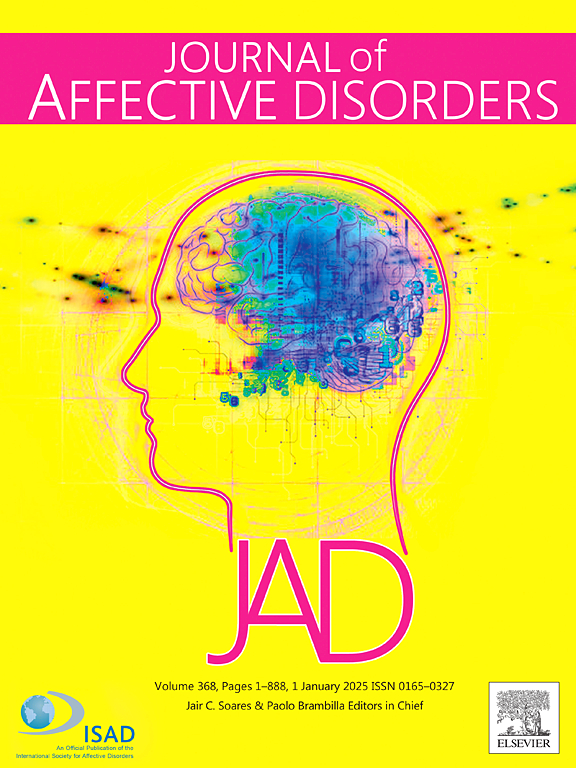Efficacy of cranial electrotherapy stimulation for treating primary and secondary depression in adults: A meta-analysis of randomized controlled trials
IF 4.9
2区 医学
Q1 CLINICAL NEUROLOGY
引用次数: 0
Abstract
Background
Antidepressants use is linked to poor response, treatment discontinuation, and treatment-resistant depression. However, evidence regarding efficacy of cranial electrotherapy stimulation (CES) in treating depression is limited. Therefore, we conducted the first meta-analysis to explore efficacy of CES in treating primary and secondary depression in adults.
Methods
PubMed, Embase, CINAHL, Web of Science, EBSCOHost, and Cochrane Library were comprehensively searched. Dersimonian-Lard random-effects model in Comprehensive Meta-Analysis 4.0 was used, presenting Hedges’ g with corresponding 95 % confidence interval (CI) for depressive symptoms and Quality of life (QoL) while odds ratio (OR) for safety and acceptability of CES. Heterogeneity was examined using Cochrane’s Q and I2 statistics with moderator analysis determining sources of variation.
Results
Sixteen randomized controlled trials involving 1148 adults were included. CES significantly reduced depressive symptoms with small effect (g = -0.33 [95%CI -0.46, -0.20]) compared to non-CES treatment; it was safe (OR = 0.84 [95%CI 0.32, 2.18]) and acceptable (OR = 0.72 [95%CI 0.41, 1.27]). CES revealed non-significant effect on improving QoL (g = 0.13 [95%CI -0.05, 0.31]). Substantial improvement of CES were observed for females (β = -0.010 [95%CI -0.019, -0.0003]), secondary depression (g = -0.42 [95%CI -0.58, -0.27]), current >100 μA (g = -0.38 [95%CI -0.58, -0.18]), frequency > 100 Hz (g = -0.50 [95%CI -0.81, -0.20]), length ≤ 30 min (g = -0.39 [95%CI -0.64, -0.14]), sessions/week ≤5times (g = -0.34 [95%CI -0.49, -0.19]), and duration ≤5 weeks (g = -0.45 [95%CI -0.63, -0.27]).
Conclusions
CES, a safe adjunctive therapy, demonstrates small effect in the treatment of depression. Future research should explore long-term effects of CES for treating adults with depression.
颅电刺激治疗成人原发性和继发性抑郁症的疗效:随机对照试验的荟萃分析
背景:抗抑郁药的使用与不良反应、治疗中断和治疗难治性抑郁症有关。然而,颅电刺激(CES)治疗抑郁症的有效性证据有限。因此,我们进行了首次荟萃分析,探讨CES治疗成人原发性和继发性抑郁症的疗效。方法spubmed、Embase、CINAHL、Web of Science、EBSCOHost、Cochrane Library进行综合检索。采用综合荟萃分析4.0中的dersimonan - lard随机效应模型,对抑郁症状和生活质量(QoL)给出了相应的95%置信区间(CI),而对CES的安全性和可接受性给出了相应的比值比(OR)。采用Cochrane 's Q和I2统计量检验异质性,并采用调节因子分析确定变异源。结果纳入16项随机对照试验,纳入成人1148人。与非CES治疗相比,CES显著减轻抑郁症状,但效果较小(g = -0.33 [95%CI -0.46, -0.20]);安全(OR = 0.84 [95%CI 0.32, 2.18]),可接受(OR = 0.72 [95%CI 0.41, 1.27])。CES对改善生活质量无显著影响(g = 0.13 [95%CI -0.05, 0.31])。女性患者的CES显著改善(β = -0.010 [95%CI -0.019, -0.0003]),继发性抑郁(g = -0.42 [95%CI -0.58, -0.27]),电流>;100 μA (g = -0.38 [95%CI -0.58, -0.18]),频率>;100赫兹(g = -0.50 [95% ci -0.81, -0.20]),长度≤30分钟(g = -0.39 [95% ci -0.64, -0.14]),每周会议≤5倍(g = -0.34 [95% ci -0.49, -0.19]),和持续时间≤5周(g = -0.45 [95% ci -0.63, -0.27])。结论sces是一种安全的辅助疗法,对抑郁症的治疗效果较小。未来的研究应该探索CES治疗成人抑郁症的长期效果。
本文章由计算机程序翻译,如有差异,请以英文原文为准。
求助全文
约1分钟内获得全文
求助全文
来源期刊

Journal of affective disorders
医学-精神病学
CiteScore
10.90
自引率
6.10%
发文量
1319
审稿时长
9.3 weeks
期刊介绍:
The Journal of Affective Disorders publishes papers concerned with affective disorders in the widest sense: depression, mania, mood spectrum, emotions and personality, anxiety and stress. It is interdisciplinary and aims to bring together different approaches for a diverse readership. Top quality papers will be accepted dealing with any aspect of affective disorders, including neuroimaging, cognitive neurosciences, genetics, molecular biology, experimental and clinical neurosciences, pharmacology, neuroimmunoendocrinology, intervention and treatment trials.
 求助内容:
求助内容: 应助结果提醒方式:
应助结果提醒方式:


